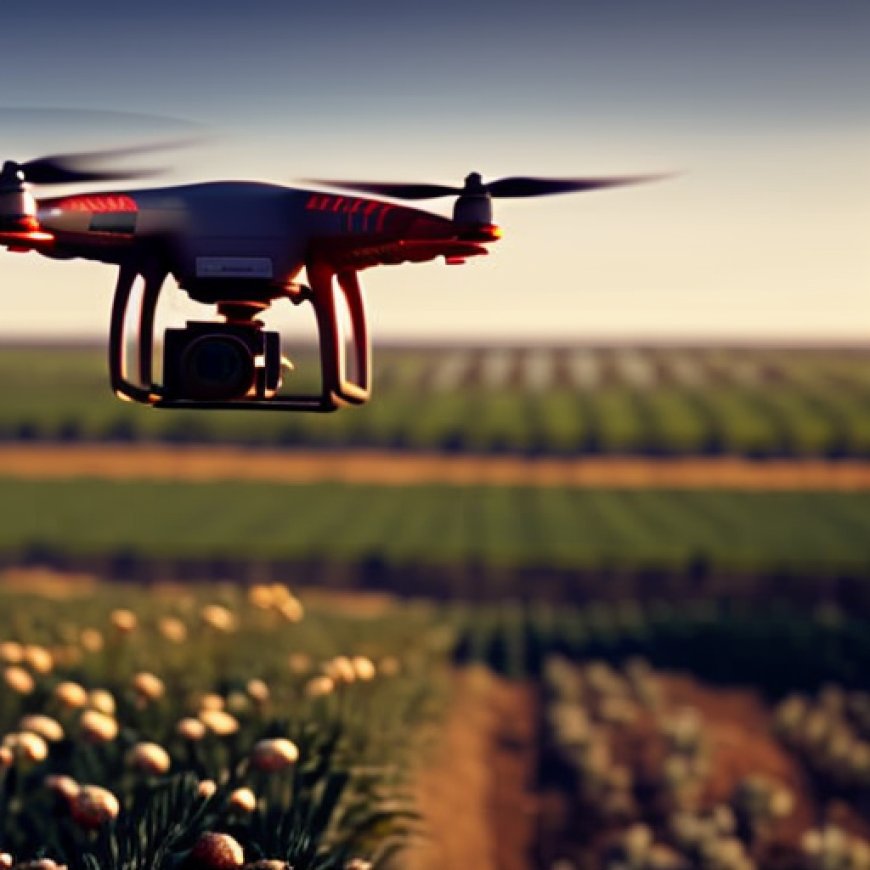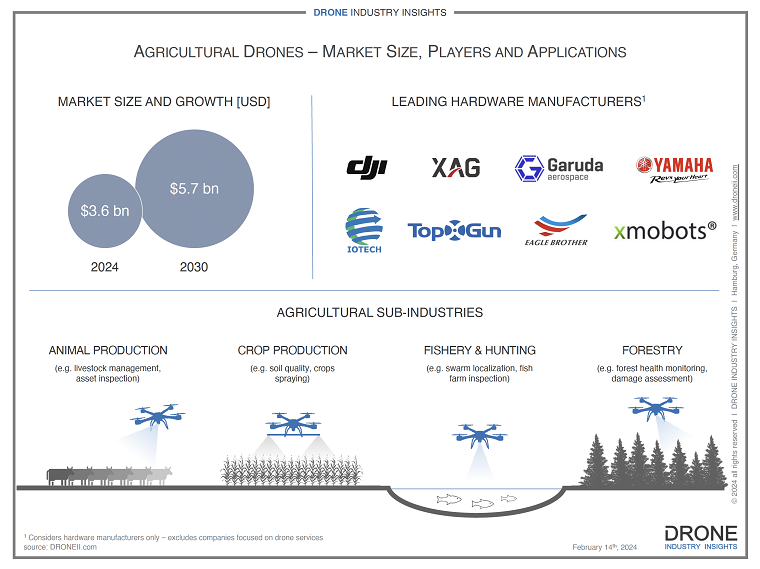The Flourishing of Drones in Agriculture
The Flourishing of Drones in Agriculture Commercial UAV News


The Growing Agricultural Drone Market and its Impact on Sustainable Development Goals (SDGs)

The agricultural drone market is not only already a leader for drone technology, it is also looking at significant growth. Based on the latest research by Drone Industry Insights, it is set to expand from $3.6 billion in 2024 to $5.7 billion by 2030. These drones are revolutionizing agriculture, offering unparalleled benefits across diverse sub-industries such as crop farming, livestock management, fishery, hunting, and forestry. This expansion reflects the broad utility and adaptability of drones in various agricultural contexts, enhancing efficiency, safety, and productivity.
Agricultural Drones Enhancing Efficiency and Productivity
In agriculture, drones offer rapid, flexible access to high-quality aerial data, a critical advantage in a sector characterized by vast, difficult terrains and the need for precise, efficient operations. They enable farmers to collect vital data and deploy resources like seeds and pesticides more effectively, saving time and costs while increasing safety. Agricultural drones have introduced new, more efficient methods for traditional tasks like planting, monitoring, and resource distribution, transforming centuries-old practices into modern, optimized processes.
Revolutionizing Livestock Management and Crop Farming
For livestock management, drones excel in monitoring and counting animals over large areas, leveraging advanced technologies like computer vision. They also play a crucial role in inspecting containment structures, ensuring the safety of farm animals from external threats. In crop farming, drones surpass traditional methods by quickly covering extensive fields, assessing soil quality, identifying plant stress, and optimizing pest control and resource application. This not only saves valuable time and resources but also significantly enhances crop yields and farming efficiency.
Benefits for Fishery, Hunting, and Forestry
The fishery sector benefits from drones by optimizing fishing operations through the precise location of fish swarms and improving fish farm management. Though controversial and legally restricted in some areas, drones offer potential benefits hunting for tasks like tracking and humanely managing wildlife. Forestry applications mirror those in crop farming but with added complexities. Drones assist in forest health monitoring, species identification, and risk management, offering a level of precision and efficiency unattainable with traditional methods. The ability to create detailed 3D models of vegetation further underscores the advanced capabilities of drone technology in managing forestry resources.
Diverse Types of Agricultural Drones
A variety of drones are used in agriculture, with multirotors dominating due to their flexibility and ease of maneuverability. Fixed-wing drones, however, are gaining popularity for their ability to cover larger areas more efficiently. Advanced equipment like multispectral cameras and robotic arms enhance the drones’ utility, enabling detailed analysis and autonomous operations.
Driving the Agricultural Drone Market Forward
Leading manufacturers and service providers from global manufacturing hubs like China and Brazil are driving the agricultural drone market forward. Despite challenges related to traditional farming practices and regulatory constraints, the sector’s growth trajectory is strong, driven by the compelling benefits drones offer to agriculture. As technology evolves and regulations adapt, drones are set to become an integral part of agricultural innovation, optimizing workflows and enhancing the sector’s overall productivity and efficiency.
SDGs, Targets, and Indicators
| SDGs | Targets | Indicators |
|---|---|---|
| SDG 2: Zero Hunger | Target 2.3: By 2030, double the agricultural productivity and incomes of small-scale food producers | – Increase in crop yields due to optimized pest control and resource application – Increase in farming efficiency and productivity |
| SDG 9: Industry, Innovation, and Infrastructure | Target 9.5: Enhance scientific research, upgrade the technological capabilities of industrial sectors, and encourage innovation | – Adoption of drone technology in agriculture for data collection and resource deployment – Use of advanced equipment like multispectral cameras and robotic arms |
| SDG 15: Life on Land | Target 15.1: By 2020, ensure the conservation, restoration, and sustainable use of terrestrial and inland freshwater ecosystems and their services | – Use of drones for forest health monitoring and risk management – Species identification through drone technology |
1. Which SDGs are addressed or connected to the issues highlighted in the article?
SDG 2: Zero Hunger
The article discusses how agricultural drones enhance crop farming by quickly assessing soil quality, identifying plant stress, optimizing pest control, and resource application. These advancements lead to increased crop yields and farming efficiency, which align with SDG 2’s goal of achieving zero hunger by improving agricultural productivity and incomes.
SDG 9: Industry, Innovation, and Infrastructure
The article highlights the use of drone technology in agriculture, which falls under SDG 9’s focus on promoting industry, innovation, and infrastructure. Drones provide rapid access to high-quality aerial data, enabling farmers to collect vital information and deploy resources more effectively. The adoption of advanced equipment like multispectral cameras and robotic arms also demonstrates technological innovation in the agricultural sector.
SDG 15: Life on Land
The article mentions how drones assist in forest health monitoring, species identification, and risk management in the forestry sector. These applications contribute to SDG 15’s target of ensuring the conservation, restoration, and sustainable use of terrestrial ecosystems and their services.
2. What specific targets under those SDGs can be identified based on the article’s content?
Target 2.3: By 2030, double the agricultural productivity and incomes of small-scale food producers
The article emphasizes how agricultural drones enhance crop yields and farming efficiency, which aligns with Target 2.3’s goal of doubling agricultural productivity and incomes.
Target 9.5: Enhance scientific research, upgrade the technological capabilities of industrial sectors, and encourage innovation
The article discusses the use of drone technology in agriculture, highlighting its role in collecting high-quality aerial data and deploying resources effectively. This aligns with Target 9.5’s aim to enhance scientific research, upgrade technological capabilities, and encourage innovation.
Target 15.1: By 2020, ensure the conservation, restoration, and sustainable use of terrestrial and inland freshwater ecosystems and their services
The article mentions how drones assist in forest health monitoring, species identification, and risk management. These applications contribute to Target 15.1’s objective of ensuring the conservation, restoration, and sustainable use of terrestrial ecosystems.
3. Are there any indicators mentioned or implied in the article that can be used to measure progress towards the identified targets?
– Increase in crop yields due to optimized pest control and resource application: This indicator can be used to measure progress towards Target 2.3 of doubling agricultural productivity and incomes.
– Increase in farming efficiency and productivity: This indicator can also be used to measure progress towards Target 2.3 of doubling agricultural productivity and incomes.
– Adoption of drone technology in agriculture for data collection and resource deployment: This indicator can be used to measure progress towards Target 9.5 of enhancing scientific research, upgrading technological capabilities, and encouraging innovation.
– Use of advanced equipment like multispectral cameras and robotic arms: This indicator can also be used to measure progress towards Target 9.5 of enhancing scientific research, upgrading technological capabilities, and encouraging innovation.
– Use of drones for forest health monitoring and risk management: This indicator can be used to measure progress towards Target 15.1 of ensuring the conservation, restoration, and sustainable use of terrestrial ecosystems.
– Species identification through drone technology: This indicator can also be used to measure progress towards Target 15.1 of ensuring the conservation, restoration, and sustainable use of terrestrial ecosystems.
Overall, these indicators provide measurable ways to track progress towards the identified targets.
4. SDGs, Targets, and Indicators
| SDGs | Targets | Indicators |
|---|---|---|
| SDG 2: Zero Hunger | Target 2.3: By 2030, double the agricultural productivity and incomes of small-scale food producers | – Increase in crop yields due to optimized pest control and resource application – Increase in farming efficiency and productivity |
| SDG 9: Industry, Innovation, and Infrastructure | Target 9.5: Enhance scientific research, upgrade the technological capabilities of industrial sectors, and encourage innovation | – Adoption of drone technology in agriculture for data collection and resource deployment – Use of advanced equipment like multispectral cameras and robotic arms |
| SDG 15: Life on Land | Target 15.1: By 2020, ensure the conservation, restoration, and sustainable use of terrestrial and inland freshwater ecosystems and their services | – Use of drones for forest health monitoring and risk management – Species identification through drone technology |
Behold! This splendid article springs forth from the wellspring of knowledge, shaped by a wondrous proprietary AI technology that delved into a vast ocean of data, illuminating the path towards the Sustainable Development Goals. Remember that all rights are reserved by SDG Investors LLC, empowering us to champion progress together.
Source: commercialuavnews.com

Join us, as fellow seekers of change, on a transformative journey at https://sdgtalks.ai/welcome, where you can become a member and actively contribute to shaping a brighter future.







